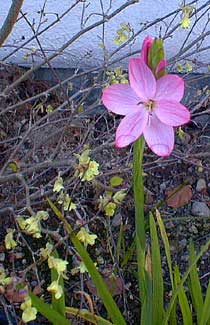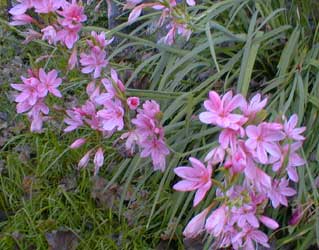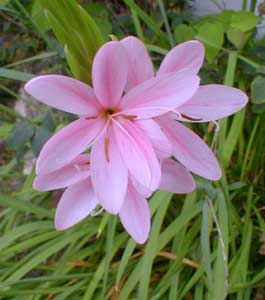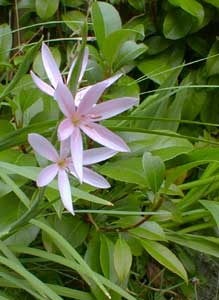
Mrs. Hegarty's
Kaffir Lily
'Mrs. Hegarty,' an Irish cultivar of Hesperantha coccinea (formerly Schizostylis coccinea), is described in all the literature as blooming primarily September through November. In zones that are less year-round temperate than is true on Puget Sound, perhaps kaffirs really do bloom only in Autumn.
Ours, however, with deadheading, are in fact everblooming. In our mild climate it's fully an autumn bloomer, but also a stunning winter bloomer, plus will have lesser reblooms throughout spring & summer. It must be said however that even though it does bloom all year round, in Autumn it is the most crowded with blooms.
The first photo was taken in March, but could just as well have been taken in July. The yellow blossoms on the shrub behind it are Butternut Winterhazel. The other photos below are from October.
 I love kaffir lilies because they bloom most gloriously later in the year than the majority of brightly flowering plants. Plus kaffir lily-grass lends evergreen patches to any largely deciduous garden all year round rather than dying back in the manner of so many lily or iris grassy clumps.
I love kaffir lilies because they bloom most gloriously later in the year than the majority of brightly flowering plants. Plus kaffir lily-grass lends evergreen patches to any largely deciduous garden all year round rather than dying back in the manner of so many lily or iris grassy clumps.I've two long patches of kaffir lilies consisting of three varieties. 'Mrs. Hegarty' & 'Oregon Sunset' create a dense border in an area of dappled shade, spreading rapidly underneath a Vine Maple.
The October photos show only 'Mrs. Hagarty' blooms, but these actually do share the area with a bright red kaffir lily called 'Oregon Sunset,' & these two take turns dominating with their blooms. For a couple weeks there'll be mostly 'Oregon Sunset' in full flower, then for a couple of weeks it'll be primarily 'Mrs. Haggerty.'
A second patch is growing in a brighter direct-sun location. Where these additional 'Mrs Hegarty' are growing there are also some with pure 'Alba' kaffirs or river lilies. The fourth photo below shows a couple blooms from the second patch, with an Evergreen Climbing Hydrangea behind the flowers.
 I used to worry a little that dappled morning sun underneath the Vine Maple wouldn't be enough for river lilies in our zone, but their grassy border in the dappled-light location has flourished even more greatly than has the second patch which gets a lot more direct sunlight.
I used to worry a little that dappled morning sun underneath the Vine Maple wouldn't be enough for river lilies in our zone, but their grassy border in the dappled-light location has flourished even more greatly than has the second patch which gets a lot more direct sunlight.There is a tendency for the shaded kaffirs to lean out into the lawned area, but I find this leaning look appealing. Locations that are moist & sunny are supposed to be the preference for this flower, yet kaffir lilies do thrive in partial shade & bloom very well, even though the flower stalks become taller with more lean to them.
They are not fussy as to soil conditions except for wanting to be permanently moist, though not boggy; it wants good drainage under persistently moist soil. I've noticed, however, they are spreading their clumps backward through their bed, toward the warmth of the house, into an area that is often quite dry due to large overhanging eaves. I would have expected them to send their rhizomes into moister sunnier ground, but they haven't spread so much toward the wetter ground.
 River lilies grow wild along the edges of South African swamps, in damp meadows, & along the sides of streams. Their prefered habitats do sometimes dry out seasonally, so for a lily that prefers moistness, it can adapt to drier locations pretty readily if it has too. However, if it experiences too much dryness, it may estivate in summer to await the rains, with some top-growth die-back; whereas with evenly moist soil year-round, the grassy leaves are very much evergreen.
River lilies grow wild along the edges of South African swamps, in damp meadows, & along the sides of streams. Their prefered habitats do sometimes dry out seasonally, so for a lily that prefers moistness, it can adapt to drier locations pretty readily if it has too. However, if it experiences too much dryness, it may estivate in summer to await the rains, with some top-growth die-back; whereas with evenly moist soil year-round, the grassy leaves are very much evergreen.It spreads by thick rhizomes which should be dug up every three or four years & separated, a chore timed for late spring or early summer, which is supposed to be kaffir lilies' quiescent time, though 'Mrs. Hegarty' doesn't necessarily take even a summer nap in our zone.
'Mrs. Hegarty' has self-seeded in the garden. When deadheading, I sometimes cut up the spent flower stalks into short lengths, & use them as mulch mixed with fallen leaves, which I likewise leave in the garden to break down naturally into leafmold. In October 2003 I spotted some unexpected tiny pink flowers erupting right out of the ground like autumn crocuses, but one-third the size of crocuses. When I first spotted them, I wondered aloud, "What the heck did I plant there?" On close inspection, they were infant kaffir lily seedings already blooming despite their tiny size.
Hesperantha coccinea 'Oregon Sunset'